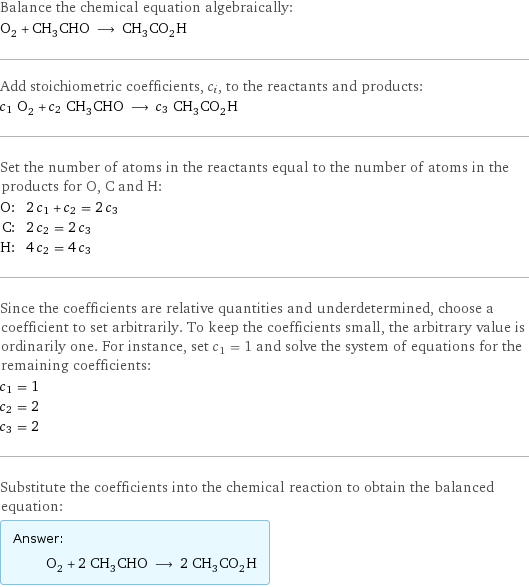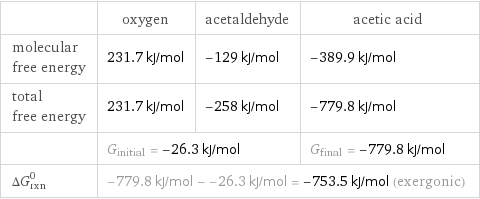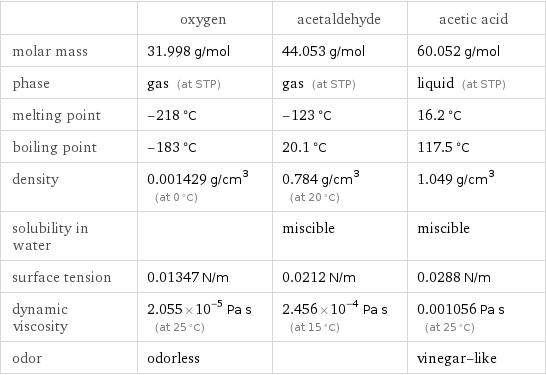Input interpretation

O_2 oxygen + CH_3CHO acetaldehyde ⟶ CH_3CO_2H acetic acid
Balanced equation

Balance the chemical equation algebraically: O_2 + CH_3CHO ⟶ CH_3CO_2H Add stoichiometric coefficients, c_i, to the reactants and products: c_1 O_2 + c_2 CH_3CHO ⟶ c_3 CH_3CO_2H Set the number of atoms in the reactants equal to the number of atoms in the products for O, C and H: O: | 2 c_1 + c_2 = 2 c_3 C: | 2 c_2 = 2 c_3 H: | 4 c_2 = 4 c_3 Since the coefficients are relative quantities and underdetermined, choose a coefficient to set arbitrarily. To keep the coefficients small, the arbitrary value is ordinarily one. For instance, set c_1 = 1 and solve the system of equations for the remaining coefficients: c_1 = 1 c_2 = 2 c_3 = 2 Substitute the coefficients into the chemical reaction to obtain the balanced equation: Answer: | | O_2 + 2 CH_3CHO ⟶ 2 CH_3CO_2H
Structures

+ ⟶
Names

oxygen + acetaldehyde ⟶ acetic acid
Reaction thermodynamics
Gibbs free energy

| oxygen | acetaldehyde | acetic acid molecular free energy | 231.7 kJ/mol | -129 kJ/mol | -389.9 kJ/mol total free energy | 231.7 kJ/mol | -258 kJ/mol | -779.8 kJ/mol | G_initial = -26.3 kJ/mol | | G_final = -779.8 kJ/mol ΔG_rxn^0 | -779.8 kJ/mol - -26.3 kJ/mol = -753.5 kJ/mol (exergonic) | |
Entropy

| oxygen | acetaldehyde | acetic acid molecular entropy | 205 J/(mol K) | 250 J/(mol K) | 160 J/(mol K) total entropy | 205 J/(mol K) | 500 J/(mol K) | 320 J/(mol K) | S_initial = 705 J/(mol K) | | S_final = 320 J/(mol K) ΔS_rxn^0 | 320 J/(mol K) - 705 J/(mol K) = -385 J/(mol K) (exoentropic) | |
Equilibrium constant
![Construct the equilibrium constant, K, expression for: O_2 + CH_3CHO ⟶ CH_3CO_2H Plan: • Balance the chemical equation. • Determine the stoichiometric numbers. • Assemble the activity expression for each chemical species. • Use the activity expressions to build the equilibrium constant expression. Write the balanced chemical equation: O_2 + 2 CH_3CHO ⟶ 2 CH_3CO_2H Assign stoichiometric numbers, ν_i, using the stoichiometric coefficients, c_i, from the balanced chemical equation in the following manner: ν_i = -c_i for reactants and ν_i = c_i for products: chemical species | c_i | ν_i O_2 | 1 | -1 CH_3CHO | 2 | -2 CH_3CO_2H | 2 | 2 Assemble the activity expressions accounting for the state of matter and ν_i: chemical species | c_i | ν_i | activity expression O_2 | 1 | -1 | ([O2])^(-1) CH_3CHO | 2 | -2 | ([CH3CHO])^(-2) CH_3CO_2H | 2 | 2 | ([CH3CO2H])^2 The equilibrium constant symbol in the concentration basis is: K_c Mulitply the activity expressions to arrive at the K_c expression: Answer: | | K_c = ([O2])^(-1) ([CH3CHO])^(-2) ([CH3CO2H])^2 = ([CH3CO2H])^2/([O2] ([CH3CHO])^2)](../image_source/951c60e4e6933ee98a46f12301ac8171.png)
Construct the equilibrium constant, K, expression for: O_2 + CH_3CHO ⟶ CH_3CO_2H Plan: • Balance the chemical equation. • Determine the stoichiometric numbers. • Assemble the activity expression for each chemical species. • Use the activity expressions to build the equilibrium constant expression. Write the balanced chemical equation: O_2 + 2 CH_3CHO ⟶ 2 CH_3CO_2H Assign stoichiometric numbers, ν_i, using the stoichiometric coefficients, c_i, from the balanced chemical equation in the following manner: ν_i = -c_i for reactants and ν_i = c_i for products: chemical species | c_i | ν_i O_2 | 1 | -1 CH_3CHO | 2 | -2 CH_3CO_2H | 2 | 2 Assemble the activity expressions accounting for the state of matter and ν_i: chemical species | c_i | ν_i | activity expression O_2 | 1 | -1 | ([O2])^(-1) CH_3CHO | 2 | -2 | ([CH3CHO])^(-2) CH_3CO_2H | 2 | 2 | ([CH3CO2H])^2 The equilibrium constant symbol in the concentration basis is: K_c Mulitply the activity expressions to arrive at the K_c expression: Answer: | | K_c = ([O2])^(-1) ([CH3CHO])^(-2) ([CH3CO2H])^2 = ([CH3CO2H])^2/([O2] ([CH3CHO])^2)
Rate of reaction
![Construct the rate of reaction expression for: O_2 + CH_3CHO ⟶ CH_3CO_2H Plan: • Balance the chemical equation. • Determine the stoichiometric numbers. • Assemble the rate term for each chemical species. • Write the rate of reaction expression. Write the balanced chemical equation: O_2 + 2 CH_3CHO ⟶ 2 CH_3CO_2H Assign stoichiometric numbers, ν_i, using the stoichiometric coefficients, c_i, from the balanced chemical equation in the following manner: ν_i = -c_i for reactants and ν_i = c_i for products: chemical species | c_i | ν_i O_2 | 1 | -1 CH_3CHO | 2 | -2 CH_3CO_2H | 2 | 2 The rate term for each chemical species, B_i, is 1/ν_i(Δ[B_i])/(Δt) where [B_i] is the amount concentration and t is time: chemical species | c_i | ν_i | rate term O_2 | 1 | -1 | -(Δ[O2])/(Δt) CH_3CHO | 2 | -2 | -1/2 (Δ[CH3CHO])/(Δt) CH_3CO_2H | 2 | 2 | 1/2 (Δ[CH3CO2H])/(Δt) (for infinitesimal rate of change, replace Δ with d) Set the rate terms equal to each other to arrive at the rate expression: Answer: | | rate = -(Δ[O2])/(Δt) = -1/2 (Δ[CH3CHO])/(Δt) = 1/2 (Δ[CH3CO2H])/(Δt) (assuming constant volume and no accumulation of intermediates or side products)](../image_source/adf1dfee31aecc6dec0ca948a64ad525.png)
Construct the rate of reaction expression for: O_2 + CH_3CHO ⟶ CH_3CO_2H Plan: • Balance the chemical equation. • Determine the stoichiometric numbers. • Assemble the rate term for each chemical species. • Write the rate of reaction expression. Write the balanced chemical equation: O_2 + 2 CH_3CHO ⟶ 2 CH_3CO_2H Assign stoichiometric numbers, ν_i, using the stoichiometric coefficients, c_i, from the balanced chemical equation in the following manner: ν_i = -c_i for reactants and ν_i = c_i for products: chemical species | c_i | ν_i O_2 | 1 | -1 CH_3CHO | 2 | -2 CH_3CO_2H | 2 | 2 The rate term for each chemical species, B_i, is 1/ν_i(Δ[B_i])/(Δt) where [B_i] is the amount concentration and t is time: chemical species | c_i | ν_i | rate term O_2 | 1 | -1 | -(Δ[O2])/(Δt) CH_3CHO | 2 | -2 | -1/2 (Δ[CH3CHO])/(Δt) CH_3CO_2H | 2 | 2 | 1/2 (Δ[CH3CO2H])/(Δt) (for infinitesimal rate of change, replace Δ with d) Set the rate terms equal to each other to arrive at the rate expression: Answer: | | rate = -(Δ[O2])/(Δt) = -1/2 (Δ[CH3CHO])/(Δt) = 1/2 (Δ[CH3CO2H])/(Δt) (assuming constant volume and no accumulation of intermediates or side products)
Chemical names and formulas

| oxygen | acetaldehyde | acetic acid formula | O_2 | CH_3CHO | CH_3CO_2H Hill formula | O_2 | C_2H_4O | C_2H_4O_2 name | oxygen | acetaldehyde | acetic acid IUPAC name | molecular oxygen | acetaldehyde | acetic acid
Substance properties

| oxygen | acetaldehyde | acetic acid molar mass | 31.998 g/mol | 44.053 g/mol | 60.052 g/mol phase | gas (at STP) | gas (at STP) | liquid (at STP) melting point | -218 °C | -123 °C | 16.2 °C boiling point | -183 °C | 20.1 °C | 117.5 °C density | 0.001429 g/cm^3 (at 0 °C) | 0.784 g/cm^3 (at 20 °C) | 1.049 g/cm^3 solubility in water | | miscible | miscible surface tension | 0.01347 N/m | 0.0212 N/m | 0.0288 N/m dynamic viscosity | 2.055×10^-5 Pa s (at 25 °C) | 2.456×10^-4 Pa s (at 15 °C) | 0.001056 Pa s (at 25 °C) odor | odorless | | vinegar-like
Units
